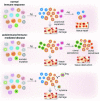Current concepts in the pathophysiology and treatment of aplastic anemia
- PMID: 24319166
- PMCID: PMC6610029
- DOI: 10.1182/asheducation-2013.1.76
Current concepts in the pathophysiology and treatment of aplastic anemia
Abstract
Historically viewed in isolation as an odd, rare, and invariably fatal blood disease, aplastic anemia is now of substantial interest for its immune pathophysiology, its relationship to constitutional BM failure syndromes and leukemia, and the success of both stem cell transplantation and immunosuppressive therapies in dramatically improving survival of patients. Once relegated to a few presentations in the red cell and anemia sessions of the ASH, the Society now sponsors multiple simultaneous sessions and plenary and scientific committee presentations on these topics. This update emphasizes developments in our understanding of immune mechanisms and hematopoietic stem cell biology and new clinical approaches to stem cell stimulation as a therapy, alone and in combination with conventional suppression of the aberrant immune system.
Conflict of interest statement
Figures



References
-
- Passweg J, Aljurf M. Treatment and hematopoietic stem cell transplant in aplastic anemia. Bone Marrow Transplant. 2013;48(2):161. - PubMed
-
- Samarasinghe S, Webb DK. How I manage aplastic anaemia in children. Br J Haematol. 2012;157(1):26–40. - PubMed
-
- Scheinberg P, Chen J. Aplastic anemia: what have we learned from animal models and from the clinic. Semin Hematol. 2013;50(2):156–164. - PubMed
Publication types
MeSH terms
LinkOut - more resources
Full Text Sources
Other Literature Sources
Medical
Research Materials
Miscellaneous

